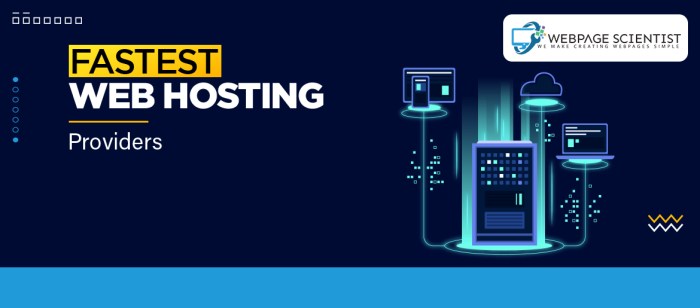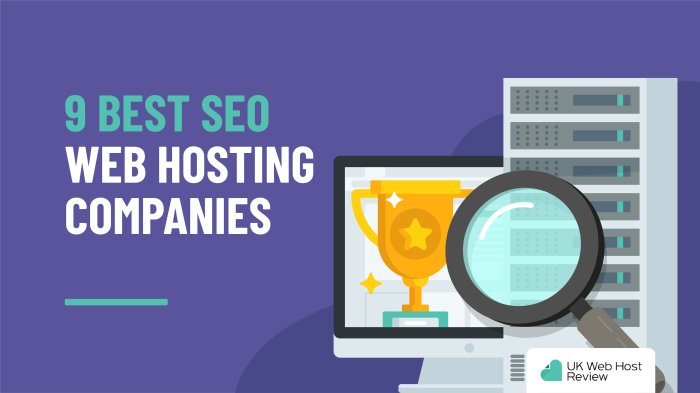Fastest Web Hosting Providers to Boost Your Site’s SEO – Fastest Web Hosting Providers to Boost Your Site’s : In the competitive online landscape, website speed is no longer a mere convenience; it’s a critical factor that directly impacts your search engine ranking, user experience, and ultimately, your business success. Google, the undisputed king of search, prioritizes websites that load quickly, understanding that users are impatient and expect instant gratification.
A slow website can lead to frustrated visitors, high bounce rates, and a decline in conversions, ultimately hurting your bottom line. This guide explores the essential aspects of choosing the right web hosting provider to accelerate your website’s performance and improve its visibility.
From understanding the intricate relationship between website speed and to delving into the key features of fast web hosting providers, this comprehensive guide equips you with the knowledge and tools to make informed decisions. We’ll dissect the various hosting types, their impact on speed, and the role of server location and network infrastructure in ensuring optimal performance. Beyond hosting, we’ll uncover the impact of website design, content optimization, and technical factors that contribute to a lightning-fast website.
Ultimately, this guide will empower you to choose the perfect web hosting provider that aligns with your specific needs and goals, setting the stage for a successful and impactful online presence.
Understanding Website Speed and its Impact on

In today’s digital landscape, website speed is no longer just a matter of user experience; it’s a critical factor in search engine ranking. A fast-loading website not only enhances user satisfaction but also significantly impacts your website’s visibility and overall performance in search engine results pages (SERPs).
The Relationship Between Website Loading Speed and Search Engine Ranking
Search engines like Google prioritize websites that offer a seamless and efficient user experience. One of the key factors influencing this experience is website loading speed. Google considers a website’s loading time as a crucial ranking signal, rewarding fast-loading websites with higher positions in search results.
Real-World Examples of How Slow Websites Affect User Experience and Conversions
The impact of slow website speed on user experience and conversions is undeniable. Imagine a user trying to access a website on a mobile device with a slow internet connection. The experience can be frustrating, leading to increased bounce rates and lost conversions. Studies have shown that a one-second delay in page load time can result in a 7% decrease in conversions.
The Role of Google’s Core Web Vitals in Website Speed Assessment
Google’s Core Web Vitals are a set of metrics that measure a website’s user experience, including its loading speed. These metrics provide valuable insights into how users perceive a website’s performance and help website owners identify areas for improvement. The Core Web Vitals include:
- Largest Contentful Paint (LCP): Measures the time it takes for the largest content element above the fold to become visible.
- First Input Delay (FID): Measures the time it takes for a user’s first interaction with a website, such as clicking a button or typing in a text field, to be processed.
- Cumulative Layout Shift (CLS): Measures the visual stability of a website, preventing unexpected page jumps or layout shifts.
Key Features of Fast Web Hosting Providers: Fastest Web Hosting Providers To Boost Your Site’s SEO
Choosing the right web hosting provider is crucial for achieving optimal website speed and performance. Several key features contribute to the speed and efficiency of web hosting services, directly impacting your website’s ranking and user experience.
Hosting Types and Speed Performance
The type of hosting you choose significantly impacts your website’s speed. Each hosting type offers varying levels of resources and performance capabilities.
- Shared Hosting: Shared hosting is the most affordable option, where multiple websites share the same server resources. However, this shared environment can lead to slower performance, especially during peak traffic hours, as other websites on the server can consume resources.
- VPS Hosting: VPS (Virtual Private Server) offers a dedicated portion of a physical server, providing more resources and better performance compared to shared hosting. It offers more control over server configuration and improved isolation from other websites, resulting in faster loading times.
- Dedicated Hosting: Dedicated hosting provides an entire server exclusively for your website, ensuring maximum resources and performance. This option offers the highest level of control and isolation, making it ideal for high-traffic websites demanding consistent speed and reliability.
- Cloud Hosting: Cloud hosting utilizes a network of servers to distribute website traffic and resources, offering scalability and flexibility. Cloud hosting providers offer various features, including load balancing, content delivery networks (CDNs), and automated scaling, contributing to faster website speeds.
Server Location and Network Infrastructure
The physical location of your server and the quality of the network infrastructure play a crucial role in website speed.
- Server Location: Websites hosted closer to your target audience experience faster loading times due to reduced latency. Choosing a server location in proximity to your users minimizes the distance data travels, resulting in quicker response times.
- Network Infrastructure: A robust network infrastructure with high bandwidth and low latency is essential for fast website performance. High-speed connections and optimized routing ensure efficient data transfer, contributing to faster loading times.
Factors Affecting Website Speed Beyond Hosting

While choosing a fast web hosting provider is crucial, it’s only one piece of the puzzle when it comes to optimizing your website’s speed. Several other factors contribute significantly to your website’s loading time, impacting user experience and .
Website Design and Development
The way your website is designed and developed can heavily influence its loading speed. Clean and optimized code, efficient use of resources, and a streamlined structure all contribute to a faster website.
- Minimize HTTP Requests: Every element on your website, like images, scripts, and stylesheets, requires an HTTP request to be loaded. Reducing the number of requests can significantly improve loading time. This can be achieved by combining multiple CSS files into one, using CSS sprites for icons, and deferring loading of non-critical resources.
- Optimize Code: Well-written and efficient code is crucial. Minifying HTML, CSS, and JavaScript files removes unnecessary characters and whitespace, reducing file sizes and improving download times. Additionally, compressing files can further reduce their size.
- Choose the Right Framework: Some frameworks are known for their performance, while others might be more resource-intensive. Selecting a framework that prioritizes speed can significantly impact your website’s loading time.
Impact of Website Content
The content on your website plays a crucial role in its loading speed. Heavy images, large videos, and complex content can significantly slow down your website.
- Image Optimization: Large images are a major contributor to slow loading times. Compressing images without sacrificing quality can significantly reduce their file size. Using optimized image formats like WebP can further improve performance. Additionally, lazy loading images, where images only load when they are visible in the viewport, can enhance perceived speed.
- Video Optimization: Videos can be even more resource-intensive than images. Hosting videos on platforms like YouTube or Vimeo can offload the burden from your server, improving your website’s loading time. If you must host videos on your website, ensure they are optimized for various devices and compressed to reduce file size.
- Text Optimization: While text is generally lightweight, excessive use of large fonts or complex styling can impact loading time. Using a minimal design and optimizing fonts can improve website speed.
Choosing the Right Web Hosting Provider for

Selecting the right web hosting provider is crucial for optimizing your website for search engines. A fast and reliable hosting solution can significantly improve your website’s performance, leading to better search engine rankings and increased organic traffic.
Comparing Popular Web Hosting Providers
To help you make an informed decision, here’s a comparison table of popular web hosting providers based on their speed, features, and pricing:| Provider | Speed | Features | Pricing ||—|—|—|—|| Bluehost | Fast | Shared, VPS, Dedicated, WordPress | $2.95/month || HostGator | Fast | Shared, VPS, Dedicated, WordPress | $2.75/month || SiteGround | Very Fast | Shared, VPS, Dedicated, WordPress | $3.95/month || GoDaddy | Fast | Shared, VPS, Dedicated, WordPress | $5.99/month || DreamHost | Fast | Shared, VPS, Dedicated, WordPress | $2.59/month |This table provides a general overview, and it’s important to consider your specific website needs and budget when making a final decision.
Reputable Web Hosting Providers Known for Fast Performance and -friendliness
Choosing a web hosting provider with a proven track record of fast performance and -friendliness is essential for optimizing your website. Here are some reputable providers known for their speed and -friendliness:* SiteGround: SiteGround is widely recognized for its fast loading speeds and excellent customer support. They offer a variety of features that are beneficial for , such as free daily backups, built-in caching, and a free SSL certificate.
Cloudways
Cloudways provides managed cloud hosting solutions that are known for their speed and scalability. They offer a range of server options, including DigitalOcean, Vultr, and Linode, allowing you to choose the best fit for your website’s needs.
Kinsta
Kinsta is a managed WordPress hosting provider that specializes in speed and performance. They offer a variety of features that are designed to optimize website speed, such as free CDN, built-in caching, and automatic backups.
WP Engine
WP Engine is another popular managed WordPress hosting provider that is known for its speed and security. They offer a variety of features that are beneficial for , such as built-in caching, free CDN, and a free SSL certificate.
Guidelines for Selecting a Web Hosting Provider, Fastest Web Hosting Providers to Boost Your Site’s SEO
When selecting a web hosting provider, consider the following guidelines:* Website Needs and Goals: Determine your website’s specific needs and goals. Consider factors such as traffic volume, website complexity, and security requirements.
Speed and Performance
Choose a provider with a proven track record of fast loading speeds and reliable performance.
Features and Resources
Look for a provider that offers the features and resources that you need, such as SSL certificates, CDN, and caching.
Customer Support
Select a provider with excellent customer support that is available 24/7.
Pricing and Value
Compare pricing plans and ensure that the provider offers good value for your money.
Best Practices for Optimizing Website Speed
Website speed is a crucial factor for success, impacting user experience, search engine rankings, and overall website performance. Implementing best practices for website speed optimization is essential for attracting visitors, boosting engagement, and improving your site’s visibility in search results.
Caching
Caching is a technique that stores copies of frequently accessed website content on a server or user’s browser, allowing for faster delivery of information. This reduces the need to process requests repeatedly, resulting in quicker page load times. There are two main types of caching:
- Server-side caching: This type of caching stores copies of website content on the server itself. When a user requests a page, the server first checks if a cached version is available. If so, the cached version is delivered, bypassing the need to process the request again. Server-side caching can be implemented using various methods, including plugins, extensions, and server configurations.
- Client-side caching: This type of caching stores copies of website content on the user’s browser. When a user revisits a website, the browser checks if a cached version is available. If so, the cached version is loaded, eliminating the need to download the content again. Client-side caching is typically handled by browser settings and can be influenced by website configurations, such as setting appropriate cache headers.
Compression
Compression involves reducing the size of website files, such as HTML, CSS, and JavaScript, without affecting their functionality. This reduces the amount of data that needs to be transmitted, resulting in faster page load times. Popular compression techniques include:
- Gzip compression: This widely used technique compresses website files on the server before sending them to the user’s browser. Browsers that support Gzip automatically decompress the files upon receiving them, ensuring that the website content is displayed correctly.
- Brotli compression: This newer compression algorithm offers higher compression ratios compared to Gzip, further reducing file sizes and improving website speed. While not as widely supported as Gzip, Brotli is gaining popularity due to its superior performance.
Lazy Loading
Lazy loading is a technique that delays the loading of non-essential website elements, such as images and videos, until they are needed. This allows the browser to load the core content of the page first, improving initial load times and providing a smoother user experience.Lazy loading can be implemented in various ways:
- Using JavaScript: This approach involves using JavaScript code to dynamically load images or videos when they are within the user’s viewport. This ensures that only visible content is loaded, reducing the initial load time.
- Using HTML attributes: Modern browsers support HTML attributes, such as `loading=”lazy”`, that allow you to specify lazy loading for images and iframes. This simplifies the implementation process, eliminating the need for custom JavaScript code.
Website Speed Testing Tools
Website speed testing tools are essential for analyzing website performance, identifying areas for improvement, and tracking progress over time. These tools provide valuable insights into various aspects of website speed, including page load times, time to first byte (TTFB), and resource loading times. Popular website speed testing tools include:
- Google PageSpeed Insights: This free tool from Google provides detailed insights into website performance, including suggestions for improvement. It offers a comprehensive analysis of various factors affecting website speed, such as server response time, resource loading times, and code optimization.
- GTmetrix: This tool offers a user-friendly interface and provides in-depth reports on website speed, including waterfall charts that visualize the loading process of each resource. It also integrates with various website speed optimization tools, making it easier to implement recommended improvements.
- Pingdom: This tool offers a wide range of features, including website speed testing, performance monitoring, and website uptime monitoring. It provides detailed reports on website performance, including insights into resource loading times, server response time, and overall page load time.
Implementing Website Speed Optimization Techniques in Popular Content Management Systems
Content management systems (CMS) provide a platform for building and managing websites. They often offer built-in features and plugins that simplify website speed optimization.
- WordPress:
- Caching plugins: Plugins like WP Super Cache, W3 Total Cache, and Cache Enabler provide server-side caching capabilities, significantly reducing page load times.
- Image optimization plugins: Plugins like EWWW Image Optimizer and ShortPixel Image Optimizer automatically compress images, reducing file sizes without compromising quality.
- Lazy loading plugins: Plugins like Lazy Load XT and a3 Lazy Load provide lazy loading functionality for images and iframes, improving initial page load times.
- Joomla:
- Caching extensions: Extensions like JCH Optimize and System – Cache provide server-side caching capabilities, enhancing website performance.
- Image optimization extensions: Extensions like JCE Media Manager and JOptimizer offer image optimization features, reducing file sizes and improving website speed.
- Lazy loading extensions: Extensions like Lazy Load and JLazyLoad provide lazy loading functionality, delaying the loading of non-essential elements until they are needed.
- Drupal:
- Caching modules: Modules like Memcache and Redis provide server-side caching capabilities, enhancing website performance.
- Image optimization modules: Modules like ImageCache and ImageMagick provide image optimization features, reducing file sizes and improving website speed.
- Lazy loading modules: Modules like Lazy Load and Lazy Loader provide lazy loading functionality, delaying the loading of non-essential elements until they are needed.
Choosing the right web hosting provider is a crucial step in maximizing your website’s speed and potential. By understanding the intricacies of website speed, the features of fast web hosting providers, and the various factors influencing performance, you can make informed decisions that drive results. Remember, a fast website is not just about user satisfaction; it’s about attracting more visitors, improving engagement, and ultimately, achieving your online business goals.
So, embark on this journey to optimize your website’s speed and unlock its full potential in the digital world.
FAQ Section
What are some examples of web hosting providers known for their speed and -friendliness?
Some reputable web hosting providers known for their fast performance and -friendliness include SiteGround, HostGator, Bluehost, and GoDaddy. These providers offer a range of hosting options, including shared, VPS, and dedicated servers, catering to different website needs and budgets.
How can I test my website’s speed and identify areas for improvement?
You can use website speed testing tools like Google PageSpeed Insights, GTmetrix, and Pingdom to analyze your website’s performance and identify areas for improvement. These tools provide detailed reports on loading time, page size, and specific optimization recommendations.
What are some common mistakes to avoid when choosing a web hosting provider?
Some common mistakes to avoid include choosing a provider solely based on price, neglecting to consider server location and network infrastructure, and overlooking the importance of customer support and security features.
How often should I optimize my website’s speed?
It’s recommended to regularly optimize your website’s speed, ideally on a monthly or quarterly basis. This ensures that your website remains fast and efficient as your content and traffic grow.
Is it necessary to use a CDN (Content Delivery Network) for website speed optimization?
While not always mandatory, using a CDN can significantly improve website speed, especially for websites with global audiences. CDNs distribute website content across multiple servers located geographically, reducing latency and improving loading times.